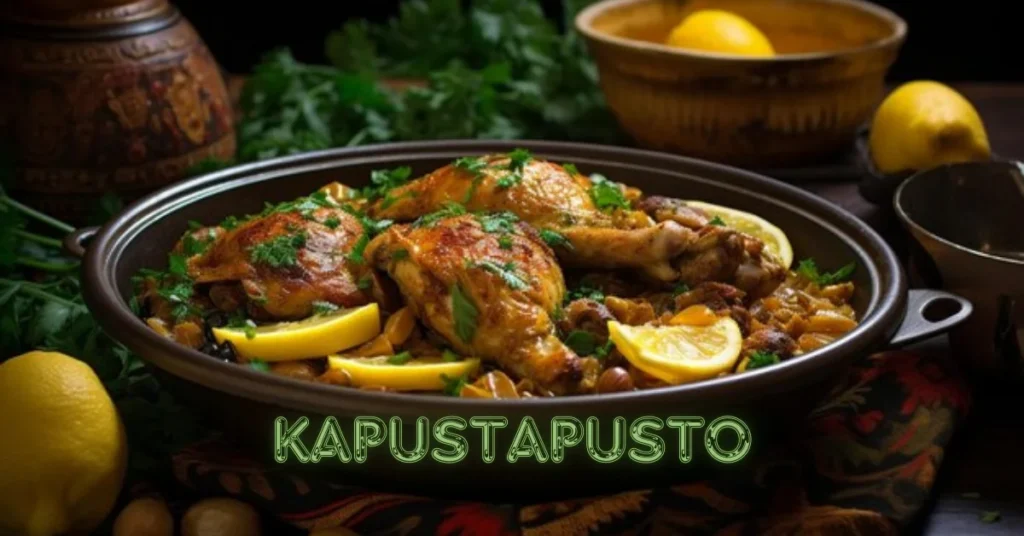Introduction to Kapustapusto cuisine
Kapustapusto is more than just a cuisine; it’s a vibrant tapestry woven from the rich history and cultural heritage of Eastern Europe. This culinary tradition has traveled through generations, bringing with it unique flavors, aromas, and stories that reflect the heart and soul of its people. Have you ever wondered what makes Kapustapusto dishes so special? Each bite tells a tale—of family gatherings, seasonal harvests, and age-old recipes passed down lovingly through time.
As we delve into the world of Kapustapusto cuisine, prepare for an exciting journey filled with traditional ingredients bursting with flavor and popular dishes that will leave your taste buds tingling. Whether you’re familiar with this delightful fare or discovering it for the first time, there’s something here to inspire every food lover’s palate. Let’s explore how this remarkable cuisine bridges cultures while preserving essential traditions that define its uniqueness.
History and cultural significance of Kapustapusto
Kapustapusto has deep roots in Eastern European culinary traditions. Its history stretches back generations, reflecting the resilience of communities that faced harsh climates and scarce resources.
Originally, this cuisine was born out of necessity, utilizing locally sourced ingredients to create hearty meals. Families gathered around tables filled with comforting dishes, sharing stories and strengthening bonds.
The name “kapustapusto” itself hints at its origins; it translates to “cabbage stew,” a staple ingredient that showcases the simplicity and richness of rural life. Over time, it became more than just food—it evolved into a symbol of cultural identity.
Festivals often feature kapustapusto dishes as a way to celebrate heritage. They serve as reminders of ancestral practices passed down through generations, ensuring that traditions remain alive in modern kitchens today.
Traditional ingredients used in Kapustapusto dishes
Kapustapusto cuisine thrives on a foundation of traditional ingredients. At the heart of many dishes is cabbage, which not only adds flavor but also reflects the region’s agricultural roots.
Potatoes are another staple, cherished for their versatility and comforting texture. They pair beautifully with various meats and provide a hearty base for many meals.
Pork often takes center stage in Kapustapusto recipes. Its rich taste enhances stews and roasts alike, offering depth to each bite.
Herbs like dill and parsley bring freshness to the table, balancing richer flavors with their bright notes.
Grains such as barley or rye form an essential part of this culinary tapestry. They add substance while connecting generations through time-honored traditions in every meal shared around family gatherings.
Popular Kapustapusto dishes and their recipes
Kapustapusto cuisine boasts a variety of hearty and flavorful dishes. One standout is the famous Kapusta, a savory sauerkraut dish that perfectly showcases fermented cabbage paired with smoked meats.
Another favorite is Borscht, a vibrant beet soup often enjoyed warm or cold. It’s rich in flavor and can be garnished with sour cream for an added touch of creaminess.
Stuffed Cabbage Rolls are also popular, filled with rice, meat, and spices. Wrapped in tender cabbage leaves, they symbolize comfort food at its finest.
For dessert lovers, Sweet Cheese Pirogi provides a delightful ending to any meal. These sweet dumplings filled with cheese offer a perfect balance of sweetness and doughy goodness.
Each dish tells its own story through ingredients and preparation methods passed down through generations. Engaging your senses while preparing these meals invites you into the heart of Kapustapusto culture.
Impact of globalization on Kapustapusto cuisine
Globalization has woven itself into the fabric of Kapustapusto cuisine, bringing both opportunities and challenges. Traditional recipes once passed down through generations now share space with international flavors. This fusion can be seen in urban eateries that blend classic dishes with contemporary culinary trends.
Travel and technology have introduced new ingredients to this heritage-rich cuisine. Fresh herbs from distant lands or spices previously unknown are now common in kitchens celebrating Kapustapusto traditions. While this broadens the palate, it also raises questions about authenticity.
Moreover, increased interest in Eastern European food has encouraged chefs to innovate while still honoring their roots. Pop-up restaurants and food festivals spotlight traditional fare alongside modern adaptations, creating a dynamic culinary scene.
However, there’s a delicate balance between embracing change and preserving identity. As globalization reshapes tastes, many continue to seek out those authentic flavors that tell stories of their cultural pasts.
Preservation of traditional Kapustapusto dishes
Preserving traditional Kapustapusto dishes is crucial for maintaining the rich cultural tapestry of Eastern European heritage. Families often pass down recipes through generations, keeping alive unique flavors and cooking methods.
Community gatherings play a vital role in this preservation. Events centered around food allow younger generations to learn from elders, ensuring that techniques are not lost over time.
Local markets also support this endeavor. They provide access to authentic ingredients necessary for crafting these cherished dishes. Sourcing locally helps maintain quality while promoting sustainability within the community.
Cookbooks dedicated to Kapustapusto cuisine further contribute to preserving its legacy. These books capture stories and secrets behind each dish, serving as both guides and historical records.
Online platforms have emerged as valuable resources too. Food blogs and social media connect enthusiasts worldwide, creating a vibrant space where traditions can thrive in modern society’s fast-paced environment.
How to experience Kapustapusto culture through food
To truly immerse yourself in Kapustapusto culture, start by visiting local eateries or family-run restaurants that specialize in this cuisine. The ambiance often mirrors the warmth of Eastern European hospitality.
Consider participating in a cooking class where traditional dishes are prepared. This hands-on experience will not only teach you recipes but also connect you with passionate chefs who share stories behind each dish.
Host a Kapustapusto-themed dinner party at home. Invite friends and serve classic meals, such as stuffed cabbage rolls or hearty borscht. Pair your dishes with regional wines for an authentic touch.
Attend food festivals celebrating Eastern European heritage. These events showcase various culinary delights while fostering community spirit and cultural exchange.
Explore online forums and social media groups dedicated to Kapustapusto enthusiasts. Engage with others who appreciate the nuances of this rich culinary tradition.
Conclusion
Kapustapusto offers a unique glimpse into Eastern European culinary traditions. This cuisine is rich with history and cultural significance, showcasing the flavors that have been passed down through generations. The traditional ingredients used in Kapustapusto dishes reflect the region’s agricultural heritage, drawing on locally sourced produce and time-honored techniques.
As globalization spreads across the globe, Kapustapusto has faced challenges but also opportunities. While modern influences have transformed some of its aspects, there remains a strong desire among communities to preserve their culinary roots. By continuing to embrace traditional practices, they ensure that these cherished recipes endure.
Experiencing Kapustapusto culture through food goes beyond just tasting dishes; it involves participating in community gatherings and understanding the stories behind each recipe. Food serves as a bridge connecting people to their heritage while inviting others to explore this captivating cuisine.
The journey into Kapustapusto is not merely about indulgence—it’s about celebrating a vibrant culture steeped in tradition and resilience. Engaging with this cuisine opens doors to appreciation for diverse backgrounds, fostering connections that transcend borders. Whether you’re trying your hand at making authentic dishes or discovering them at local eateries, there’s much joy found within every bite of Kapustapusto.
FAQs
1. What is Kapustapusto?
Kapustapusto is a traditional Eastern European dish, often translated as “cabbage stew.” It features cabbage as a key ingredient, combined with potatoes, meats, and spices to create a hearty and flavorful meal deeply rooted in cultural heritage.
2. What ingredients are essential in Kapustapusto?
The core ingredients of Kapustapusto include cabbage, potatoes, pork, and various herbs and spices such as dill and parsley. These components come together to create a rich, comforting dish that highlights regional flavors.
3. How has globalization affected Kapustapusto?
Globalization has introduced new ingredients and fusion styles to Kapustapusto, blending traditional recipes with international flavors. This evolution brings both exciting innovations and challenges to preserving authentic tastes.
4. How can I experience Kapustapusto culture firsthand?
To experience Kapustapusto culture, try visiting local Eastern European restaurants, participate in cooking classes, host a themed dinner party, or attend food festivals that celebrate this rich culinary tradition.
5. What are some popular Kapustapusto dishes?
Popular Kapustapusto dishes include Kapusta (fermented cabbage stew), Borscht (beet soup), Stuffed Cabbage Rolls, and Sweet Cheese Pirogi. Each dish offers a unique taste of Eastern European comfort food.







